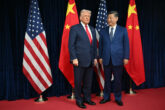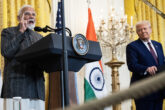October 20, 2020
What to Do About Xinjiang
Last month, the Trump administration announced a limited set of new restrictions on imports from Xinjiang. The move came in response to a rising chorus of congressional voices calling for the U.S. to act against the forced reeducation and labor regime in the Muslim-majority region in China. Yet the new restrictions have limited reach. Even in an election year when President Trump sees clear political gain in bashing China, he has left untouched his most potent weapons to punish human rights abuses in Xinjiang.
A more aggressive U.S. approach is needed in order to generate the sort of economic reaction required to have any hope of influencing Chinese policymaking.
While the Trump administration has slowly but steadily increased pressure, it failed to accelerate coercive policy to a level that would really cause Chinese President Xi Jinping to second guess his policy. In fact, Xi recently doubled down, again publicly endorsing the current Xinjiang strategy, and policy targeting non-Han Chinese is growing stricter in Tibet and Mongolia. A more aggressive U.S. approach is needed in order to generate the sort of economic reaction required to have any hope of influencing Chinese policymaking.
Read the full article in Lawfare.
More from CNAS
-
Indo-Pacific Security / Energy, Economics & Security
How to Win the Economic War with ChinaTrump's approach to China has run aground, giving Beijing unprecedented advantage in the economic conflict....
By Edward Fishman & Julian Gewirtz
-
America’s Self-Loathing Is a Losing Hand
This article was originally published in The Washington Post.Around 10 years ago, the United States began a historic shift in its grand strategy toward China, abandoning the b...
By David Feith
-
Indo-Pacific Security / Energy, Economics & Security / Technology & National Security
Selling AI Chips Won’t Keep China Hooked on U.S. TechnologyU.S. policy should not rest on the illusion that selling chips can trap China inside the American tech ecosystem....
By Janet Egan
-
Will New Delhi-Beijing Move Beyond Friction Points? | Ex-White Official On India-China Reset
Prime Minister Narendra Modi on Friday said that India and China, as two major economies, must work together to bring stability to the global economic order. NDTV's Gaurie Dwi...
By Lisa Curtis




